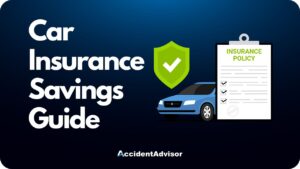“I got rear-ended. How much money will I get?” This is a question that most people eventually think to themselves after being in a car accident. Settlements in accidents involving rear-end collisions depend on many factors, including not only the conditions of the crash but also your actions immediately following it.
If you’re wondering what to do if you get rear-ended, this article breaks down the basics of what makes rear-end collisions dangerous and how you should respond if you’re in one.
Remember that a personal injury attorney is the best source of information on your specific situation, including how you can get the most money for your injury.
Table of Contents
- Rear-end Collision can be Deadly
- Common Rear-End Accident Injuries
- What to Do After a Rear-End Accident
- What NOT to Do After Getting Rear-Ended
- What to Do While Recovering from the Crash
- Rear-end accidents without vehicle damage
- Rear-end Collision Hidden Damage
- Establishing fault for rear-end accidents
- I Got Rear-Ended – How Much Money Will I Get?
- Summary
Rear-end Collision can be Deadly
Rear-end collisions are among the deadliest type of car crashes. They often occur because drivers can’t see them coming, leaving them at the mercy of their car’s safety features and the speed of the oncoming vehicle.
According to the NHTSA, nearly a third of all accidents resulting in serious bodily injuries are rear-end collisions. Additionally, rear-end collisions result in millions of dollars in damages to both body and property every year, including but not limited to these common injury types:
Common Rear-End Accident Injuries
- Back and neck injuries can result in both acute pain as well as chronic imbalances that could require long-term physical therapy
- Head and brain injuries can result in concussions as well as neurological disorders that could have a lasting impact on a person’s ability to focus, sleep, and work.
- Whiplash, which is caused by the sudden motion of the car throwing the person forward and back, can result in other neck and spine injuries
- Wrist, hand, and arm injuries resulting from rear-end collisions can have a lasting impact on a person’s ability to drive, write, or work
- Seatbelt injuries, caused by the force of the collision pushing a person’s body into their seatbelt, can cause bruises, break ribs, or even damage organs
This is not an exhaustive list of potential injuries resulting from a rear-end collision. A rear-end collision can also cause hidden damage that isn’t apparent for days or even months after the date of the accident.
What to Do After a Rear-End Accident
These are the actions that will not only strengthen your claim or lawsuit but also keep you and others safe following a rear-end collision:
- Check for injuries – This is the first step all drivers should take, checking themselves, their other passengers, and the people in the other car to get an idea of how serious the situation is.
- Call 911 – Regardless of whether anyone is injured, call 911 to ensure that the proper emergency parties are alerted to the accident. They will need to check everyone for injuries as well as remove the cars, file reports, and make sure everyone gets home safely.
- Watch what you say – Though safety is the most important concern following a rear-end collision, you should already be watching what you say. The wrong reaction can damage your case or even get you into trouble.
- Take pictures – Use your phone to take pictures of both cars, including their license plates, your injuries, any property damage, and anything else that seems relevant to the accident. You can even take videos for a more complete record.
- Identify witnesses – Any nearby witnesses, including other drivers and passersby, should be approached and identified in case their testimony is needed later.
- Get the other driver’s information – One of the most important things you can do is retrieve the other driver’s details, including their name, license number, phone number, and insurance information. This ensures that you can verify the people involved with the accident and begin the insurance claims process.
- Cooperate with paramedics – Do what the paramedics tell you to and tell them about your injuries in detail. Failing to do this can hurt your case later (see below).
- Cooperate with law enforcement – As always, make sure you cooperate with the police once they arrive. Answer their questions and try to avoid any unnecessary confrontations, which could hurt your case.
What NOT to Do After Getting Rear-Ended
In order to make sure the settlement goes your way, you should make sure to take certain actions immediately following a rear-end car accident, as well as avoid crucial mistakes that can cost you your whole case.
5 Mistakes to Avoid When Rear-Ended:
- Working out a deal with the other driver – Deals such as working out payment for the damages without going through insurance can easily backfire. Don’t make such a deal and don’t accept one if the other driver approaches you with one.
- Refusing medical care at the scene – Refusing medical care will allow the insurance company to claim that you were not injured by the accident. Even though injuries may not be painful at the scene, you should still accept medical care to maintain consistency for your injury claim.
- Failing to notify your insurance company – This will automatically make it difficult for you to claim the accident since insurance companies require prompt notification to process anything in your favor related to an injury settlement.
- Posting on social media – Avoid talking about the accident online, for two reasons. The first is to protect those involved in case of injury or embarrassment. The second is to avoid making claims inconsistent with your eventual case. If you play off the accident as no big deal, the opposition will use this against you when you try to get money for your injuries.
- Using questionable medical care providers – Immediately following the accident, you should see an accredited healthcare provider, such as an emergency room specialist or family doctor. Only seeing a service provider on the side, such as a chiropractor or physical therapist, could hurt your case by failing to create detailed records of your injury at the time of the accident.
What to Do While Recovering from the Crash
To summarize, remember to take these important steps immediately following a rear-end collision:
- Write it all down, including your actions leading up to the accident, your pain, and the reactions of the other driver.
- Notify your insurance company immediately following the accident so they can begin processing your claim.
- Notify the at-fault driver’s insurer so they can do the same.
- Follow your doctor’s orders so that the insurance company can’t claim later that you are partially at fault for your pain.
- Gather medical bills and wage statements so you keep track of the full scope of the damages resulting from your accident.
- Get a copy of the police report so you have the official record of the situation.
- Consider hiring a car accident attorney so they can organize this information for you, advise you on your next move, and help you form a strong case in your defense.
Rear-end accidents without vehicle damage
No-damage accidents are just as important to report as any other. The vehicles still need to be inspected, the police report still needs to be filed, and the passengers of both cars still need to be checked for injuries.
Failing to follow the proper procedure for any accident, regardless of the damage, can result in faulty or unsuccessful claims, as well as out-of-pocket costs to you.
Rear-end Collision Hidden Damage
Rear-end collisions often result in hidden damage even if the cars do not appear to be damaged. A sudden jolt can damage a car’s engine. The collision itself, no matter how small, can damage the car’s frame and cause alignment issues, suspension problems, or even electrical damage.
This damage may not be evident until later. Unfortunately, by that point, the statute of limitations will have passed on how soon after the accident the damage needs to be inspected in order to be claimed.
Make sure your car is inspected as soon as possible to prevent the insurance company from claiming that the damage was not caused by the accident.
Establishing fault for rear-end accidents
Rear-end accidents will be settled differently depending on whether the accident occurs in one of the 12 no-fault states or 38 at-fault states. In a no-fault state, the insurance policy of the driver who causes the accident pays the same as the insurance company of the driver who was not at fault. In every other state, establishing fault is a key step to making a settlement after a rear-end collision.
It may not always be clear who is at-fault. The reporting officer may file in his/her report the circumstances that ultimately determine fault. However, the shortcut to determining fault is to remember that the driver in the back is almost always at fault since they’re the car that crashed (even if they didn’t cause it to happen).
I Got Rear-Ended – How Much Money Will I Get?
The payout for a rear-end collision settlement varies widely based on the conditions of the accident, the injuries sustained, the fault of each party, and the negotiations with the insurance adjuster. However, the average settlement is around $15,000 or less.
Summary
Your actions following a rear-end collision can directly impact how much you win in the settlement. The insurance company will be looking not only at the conditions of the accident but also at your reaction to it both to find fault and to get themselves off the hook. Are you acting inconsistently with your alleged injuries? Did you follow the necessary procedures to make sure you and everyone else were safe following the accident?
To make sure you get the settlement you deserve, we outlined the do’s and don’ts of your actions following a rear-end collision. In summary, you should get as much information as you can, accept all help that is given to you by accredited authorities, and watch what you say in the days (even the minutes) following the accident.
If you follow the steps outlined above, you should be prepared to make a case after a rear-end collision. However, every situation is different. A personal injury attorney can work you through these steps, gather the information that you otherwise might not be able to, and help you make a winning case following a rear-end collision.
Rear-end collisions are often caused by unsafe lane changes. Learn who is at fault in a car accident when changing lanes.

Rocky Horton
Author
Rocky Horton is a health and safety expert from Chapel Hill, NC. He is the founder of AccidentAdvisor and has been featured in Forbes, Bloomberg, and other publications. Learn more.













